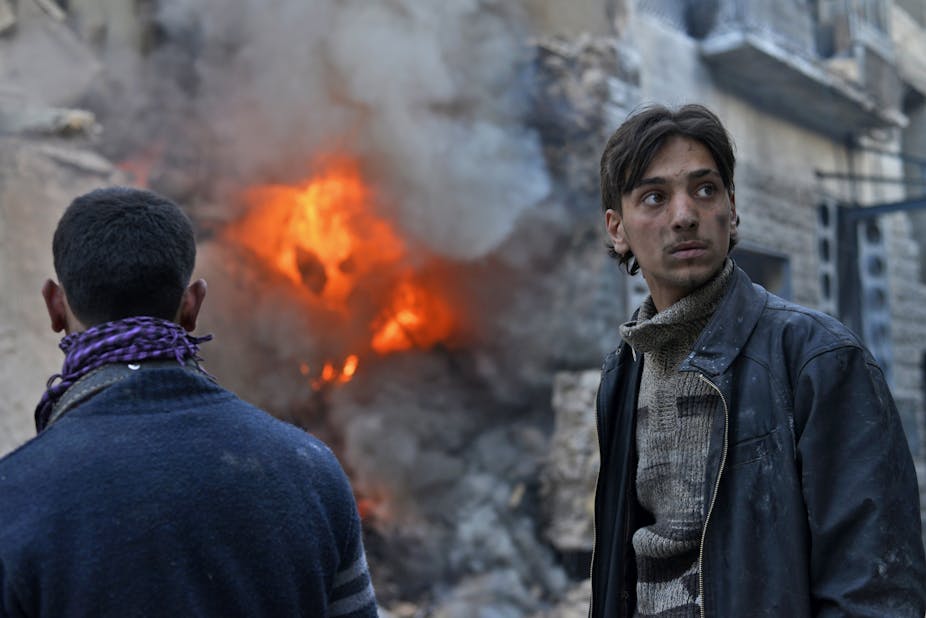February 2015 has already seen some major developments in Syria’s four-year conflict. At the start of February, rebels launched more than 100 rockets into Damascus and the Assad regime fired mortars on areas of its own capital, hoping to discredit the insurgents. At least six people were killed in the attacks.
Then came almost 50 regime air strikes on opposition-held areas near Damascus, which killed at least 82 people. Another 25 were killed in Aleppo when a barrel bomb hit a bus on a roundabout.
Meanwhile, rebels also claimed to have blown up 30 men fighting for the Assad regime – Hezbollah troops, Iranians, and Iraqis among them – at a militia headquarters west of Damascus.
All this while US-led coalition air strikes were carried out in eastern Syria against the Islamic State (IS), with Jordan in particular vowing to “wipe them from the face of the Earth” after the group murdered a captured pilot.
Take a look at the world’s media coverage, though, and you might be forgiven for thinking things were rather more quiet.
Silence
If you read The New York Times, you are unlikely to learn about much of this; the newspaper has no reporting from correspondents, only a Reuters report. The same is true of the Washington Post, CNN, and al-Jazeera English. And the BBC? As the attacks and the deaths mounted on February 5, its lead story was on the conviction of former pop star Gary Glitter on sexual assault charges; the corporation later made partial amends on its website with a story headlined Syria Conflict: Dozens Killed in Heavy Damascus Fighting.
However, both the BBC and Reuters articles relied heavily on the British-based Syrian Observatory for Human Rights, which often passes off rumour and chatter gleaned from social media as a news “network” inside Syria.
There are obvious practical reasons why gathering and circulating important news from Syria is such a fraught business. The world’s media has had to withdraw journalists because of threats to their security, drastically elevated by the rise of Islamic State, and most local stringers have had to flee the country for the same reasons. The fog of war and the attempts by all sides to “spin” events makes independent verification a nightmare.

But it’s still possible to provide in-depth day-to-day coverage of the conflict, with careful analysis of the political, economic, humanitarian, and military dimensions. Even a small news organisation can work with local activists, citizen journalists, and official sources from all sides to keep readers informed and ask challenging questions.
The real problem is not the impossibility of “seeing” what is happening in Syria. The problem is that instead of dealing with the complexity of the crisis, it’s much easier to cling to simple and often misleading narratives to explain what’s going on.
Towards the end of 2014, the favourite narrative (which never quite played out) could be summed up as “Assad is winning”. This year, the theme is “jihadists versus extremists versus jihadists”: this refers to both the Islamic State, which is fighting against Syria’s rebels, and to the “al-Qaeda-linked” Jabhat al-Nusra, which often fights alongside those rebels (but not always).
The international attention given to IS is of course understandable. However, overlooking the travails of Syria’s insurgents and the opposition to “Jabhat al-Nusra” is a serious distortion of the situation.
Main attraction
While its paramilitaries have proved effective enough on the battlefield, Jabhat al-Nusra provides only a fraction of the forces fighting against the Assad regime. It is small compared to the largest insurgent factions, the Islamic Front and the Free Syrian Army. These are part of blocs with the vast majority of Syria’s rebels, such as the Sham Front and Southern Front, which go almost unnoticed in Western media.
In recent months, these assorted anti-Assad groups have not only turned the tide on the Damascus regime’s forces, but have made notable advances throughout Syria. Sometimes working with Jabhat al-Nusra, they have moved into towns and villages and captured Syrian military bases.
They now control most of north-west and south-west Syria, and, in January 2015, they advanced from the south towards Damascus. They have also been battling the Islamic State throughout Syria, from Aleppo Province in the northwest to Hama and Homs Provinces in the centre, to the greater Damascus area.
But without any “jihadists” or “extremists” for the headline, it seems this real news hardly registers outside Syria itself.
This just in
Many analysts have effectively given up on thorough evaluation, since it’s far easier and more dramatic to post the latest social-media flutter about a foreign fighter. An entire website is dedicated to “Jihadology”, and a leading news agency creates “Under the Black Flag” on the Islamic State, with critiques such as “‘Watch Out For Satanic Earrings!’ IS Publishes Women’s Manifesto”.

In contrast, relatively little journalistic time is being spent monitoring the state of the Syrian opposition and the Assad regime, or indeed the situation of the many Syrian people who do not align with one of the competing sides.
The outcome is that there are two very different Syrian conflicts. On the one hand there’s the byzantine soap opera rendered in the international media, a saga of slaughter in which the villainous Islamic State outshines Assad and extremist factions upstage his other opponents. The current episode is “Jordan Unleashes Wrath on Islamic State”, in which the extent, location and impact of Jordan’s claimed air strikes are starting to become clear.
Meanwhile, the more substantial Syrian conflict – the one with another 200 deaths daily, and 300,000 since 2011, with 4m refugees worldwide and 7m people displaced inside the country – has all but disappeared from view.

